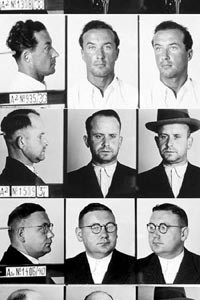The traveling exhibition Nazi Persecution of Homosexuals, 1933-1945, organized by the United States Holocaust Memorial Museum and now on display at Pittsburgh's American Jewish Museum, is a poignant but objective document about an under-recognized aspect of the Holocaust.
Curator Edward J. Phillips begins the story during the Weimar Republic, the liberal 14-year period between the 1919 Treaty of Versailles and Hitler's appointment as chancellor, in 1933. During Weimar, homosexual culture discreetly burgeoned, and Phillips includes multiple images of smiling patrons dancing and drinking at same-sex social clubs.
Still, even in the mid-1920s, stricter interpretation of the German Criminal Code -- which had condemned "indecency" between males since 1871 -- resulted in increased conviction rates. And by 1935, Hitler was encouraging the public to report all suspicious male activity. The penalty for engaging in unsanctioned sex was expanded to include a year of "protective custody." Most of the convicted were sent to concentration camps, tortured, and worked to death.
Some sought out Schutzehe (protection marriages) with willing women. Phillips chose a particularly haunting photograph of Paul Otto and his longtime partner, Harry, who sit on a bench before a dark woods. Paul and Harry are in sharp focus; Paul's wife, who stands with her hand placed protectively on his right shoulder, is but an apparition. Having moved before the shutter closed, she dissolves into abstraction. The candid portrait inadvertently symbolizes the trio's necessary affiliations.
Mugshots appear throughout the exhibition, and put a startled human face on statistics about the condemned. In fact, the upper borders of each of the show's storyboards display the riveting gazes of various arrestees. While the police mugshots sometimes emanate an air of insolence, in the 32 portraits of camp inmates, terror is unmistakable.
Still, there are images of triumph and defiance, too, like the piercing gaze of orchestra conductor Frieda Belinfante, a lesbian, who helped organize destruction of the Amsterdam-based Nazi Population Registry Office in 1943. Wearing men's clothing, Belinfante survived and emigrated to America in 1947.
While the show concludes with lithographs by camp survivor Richard Grune, thanks to the exhibition's circuit-style organization, Grune's 1947 work "Solidarity" also serves as the show's frontispiece. In the print, one concentration-camp inmate supports another who has collapsed. Having spent time in both the Sachsenhausen and Flossenbürg camps, Grune created a collection of these works after his escape. Although he had studied at the Bauhaus School under Paul Klee and Wassily Kandinsky, Grune creates more in the spirit and style of Kathe Köllwitz, known for her poignant, socially conscious prints and drawings. His lithographs -- the visceral "Four Kapos Beating a Prisoner," the spectral "Prisoners Incapable of Work on the Way to the Crematorium" -- reveal the staggering cruelties of camp life.
In her famous 1975 New York Review of Books essay, "Fascinating Fascism," Susan Sontag discusses how the sexual subculture and popular film of the 1970s had reclaimed official Nazi regalia specifically for its eccentric sexual appeal. She attributes this phenomenon to National Socialism's rigid moral restrictions and contradictory undercurrents -- a complicated paradox visible in the era's "official" German art, which often focused on the idealized male nude.
Nazi Persecution of Homosexuals, however, never broaches such painful ironies, making no reference to the homoerotic quality of official German art and other cultural elements. Perhaps that's a missed opportunity. In any case, curator Phillips' focus on historical certainties -- period photographs, cartoons, original document images and personal accounts -- seems like plenty. The show deftly unravels a knotted historical chronology and infuses cold fact with an empathetic humanity. And, especially given the limitations of a traveling exhibition of two-dimensional artifacts, it does so to powerful effect.
Nazi Persecution of Homosexuals, 1933-1945 continues through Feb. 6. American Jewish Museum (Jewish Community Center), 5738 Forbes Ave., Squirrel Hill. 412-521-8010















